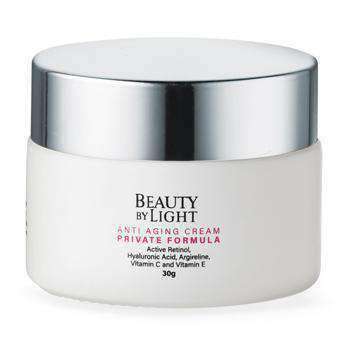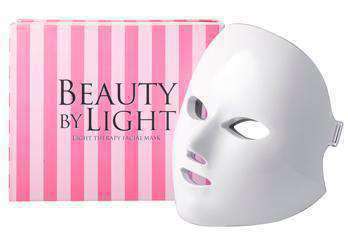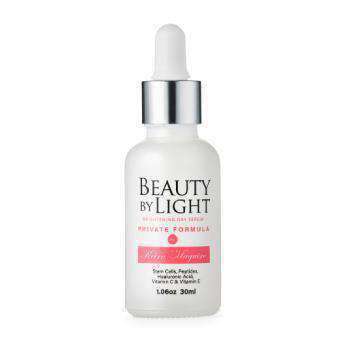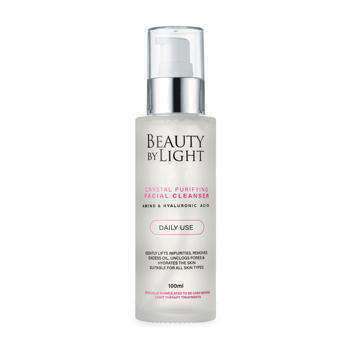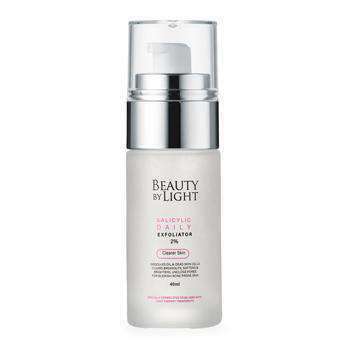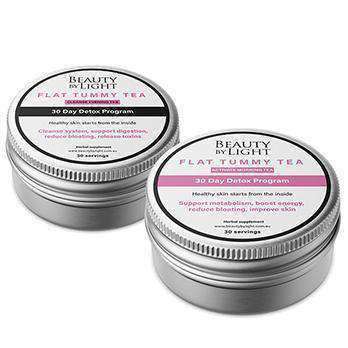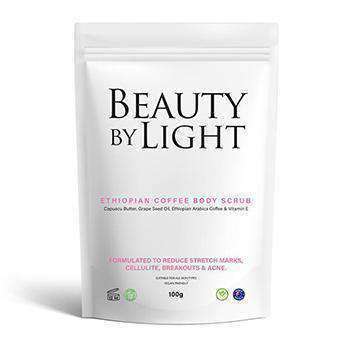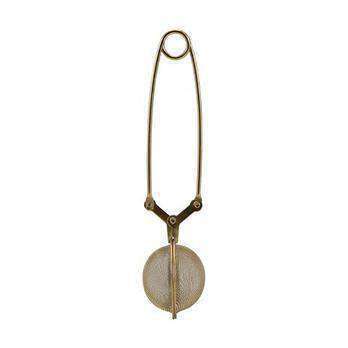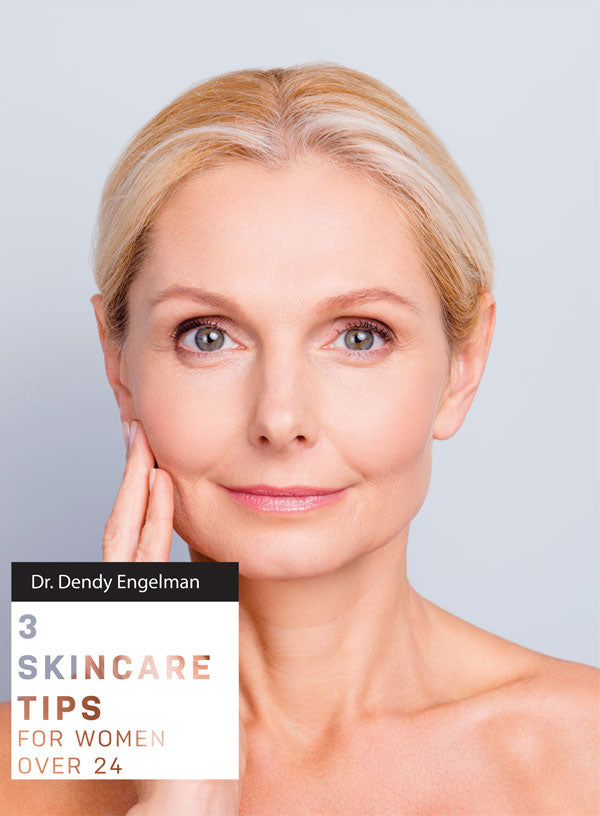3 SKINCARE TIPS FOR WOMEN OVER 24
TIP 1: LED Light Therapy Mask
Light Therapy is probably the most used treatment by professional models and actors. Recently light therapy masks have become so affordable that everyone can now afford doing the treatment from home. As this is by far the most valuable tip we will go in depth about how it works and what to look for in a light therapy mask.
How does LED Light Therapy Work?
We ask Dendy Engelman, MD: Cosmetic Dermatologist at MDCS Dermatology.
LED means light-emitting diode. “It works by emitting infrared lights in different wavelengths/spectrums, which have different skincare benefits,” says Engelman.
Red light naturally stimulates the production of collagen in skin cells, responsible for skin firmness and elasticity. Increased collagen reduces fine lines and wrinkles and shrinks pores, improving skin texture and promoting smooth, youthful skin. Green light inhibits excess melanin production in the lower levels of the dermis, preventing it from travelling to the visible surface of your skin. Existing melanin clusters are also broken down, reducing age-spots and hyper-pigmentation resulting in smooth, even skin tone. Blue light destroys bacteria. Bacteria in acne contain Porphyrins, accumulating in pores and causing breakouts and inflammation. The blue light wave-length kills these light-sensitive Porphyrins both above and below the skin, reducing acne, calming inflammation and redness, and leaving you with a clearer, brighter, smoother complexion. The yellow light increases the exchange of oxygen within skin cells, stimulating circulation and improving the cells ability to eliminate toxins. Increased toxin elimination improves tone, clarity and texture of skin resulting in a glowing, dewy complexion. The cyan light promotes healing, while soothing inflamed or damaged skin. This also assists with reducing the size of swollen capillaries, improving skin tone and clarity. The purple LED wavelength has an antibacterial effect, helping to treat acne, while also stimulating collagen production to treat fine lines and wrinkles. White light (infrared light) penetrates deep into the skin cells, accelerating active tissue metabolism for an enhanced improvement in collagen and elastin production.
How to pick the right device?
There are so many devices out there claiming to be real light therapy devices but most are not. We will explain what to look for when picking a device.
Make sure the LED Light therapy mask is not rechargeable or battery operated. These devices will never produce enough energy to give any real benefits. Make sure the Leds can produce at least 25 joules of energy per cm2 in 15 minutes. The usual dosage for adequate light therapy is around 32 joules per cm2 in 15 minutes and anything above 25 joules per cm2 will be fine. Check that the leds being used are in fact Narrow Band SMD leds. SMD stands for surface mount and these leds produce 4 times the output of the older leds that you see in older light therapy devices. The leds should look like little microchips.

How to use your light therapy mask at home?
Depending on your main skin concern, treatment times will vary but the recommended time is usually around 15 minutes per day if your device is producing 32 Joules per cm2 in 15 minutes. If it isn't producing this you can use this formula to work out how long your treatment needs to be.
We will use the Beauty By Light Led Light Therapy Mask brand as an example which produces 36 mW/cm2. This means in 15 minutes you can get 36 (mW/cm2) x 900(seconds of treatment) / 1000 = 32.4 joules/cm2 of treatment in 15 minutes.
Most skin concerns require more then one light to be used and that means in total you may be getting 66 joules/cm2 in 30 minutes which is fine but do not exceed this in one day. We recommend asking the manufacturer of the product for their recommendation. Some companies even offer personalised treatment plans when you buy their products such as Australian Company Beauty By Light. Beauty By Light have recently released a new version of their best selling mask. The Beauty By Light V3 is around 80% lighter and still provides the right amount of energy. They do this by using the latest release of SMD LEDs which produce 1.5 times more energy than previous SMD LEDs. They also redesigned their mask to be super comfy. They also designed it in a way to allow you to wear additional eye protection in the form of medical grade eye goggles. If you are looking at getting your own light therapy mask i highly recommend you check out their website https://www.beautybylight.com.au/products/beauty-by-light. Word of warning! Stay away from those cheap ebay knock-offs that come with neck attachments. They are toys and do not use real SMD LEDs hence why they are so cheap.





Is light therapy safe?
- Unlike other types of light therapy, LEDs do not contain ultraviolet rays. Therefore, they’re safe for regular use.
- LED light therapy doesn’t cause burns compared to other anti-aging treatments such as chemical peels, dermabrasion, and laser therapy. It may be safe for all skin colours and types.
- If you take Accutane for acne you should consult your doctor before doing light therapy.
- Side effects are rare and if you suspect any side effects you should consult your doctor immediately.
- Light therapy is not dangerous on the eyes unless you have an extremely rare underlying eye disease in which any bright light would be a concern and you should definitely wear eye protection or close your eyes when doing treatment from home. Check out their video below.
tip 2: Retinol cream
Retinol cream might sound scary, but adding a retinol cream or serum to your skincare routine has been proven to not only reduce fine lines and wrinkles, but also to help prevent them forming. As well as their wrinkle-busting promises, retinol can help with uneven skin tone, texture and pore size.
Retinoids work by prompting surface skin cells to turn over and die rapidly, making way for new cell growth underneath. They hamper the breakdown of collagen and thicken the deeper layer of skin where wrinkles get their start.
How to use:
Apply a pea size amount to your skin only. Only use at night as retinol will increase sensitivity to sunlight and will breakdown in light. We recommend introducing retinol to your skin slowly by starting with once per week and increasing to twice per week, then three time per week until your skin can tolerate it daily. We recommend using a retinol cream that contains vitamin E and hyaluronic acid as this well help keep the skin hydrated. For best results use retinol after light therapy. Avoid applying under eyes if you have really sensitive skin and instead use a good eye cream for those areas.
This anti-aging cream from Beauty By Light contains Retinol, vitamin E, Vitamin C, Peptides and Hyaluronic acid. That means it is also a moisturiser and minimises irritation.
TIP 3: SALICYLIC ACID
First off, let's establish what salicylic acid is. It's a little complicated, but the exact structure of salicylic acid is important in explaining why (and how) it works so well. When it comes to skin-care products, there are two classes of acids you'll see often: beta hydroxy acids (BHAs) and alpha hydroxy acids (AHAs).
"Salicylic acid is a beta hydroxy acid," says cosmetic chemist Randy Schueller. "[This] means the hydroxy part of the molecule is separated from the acid part by two carbon atoms, as opposed to an alpha hydroxy acid where they're separated by one carbon atom."
Furthermore, salicylic acid is actually derived from willow bark, says cosmetic chemist Ron Robinson, and it belongs to a class of ingredients called salicylates. Are you still with us? Good, because this is where it gets fun. "This structure is important because it makes salicylic acid more oil-soluble so it can penetrate into the pores of the skin," Schueller says.
Both alpha and beta hydroxy acids exfoliate the skin, but AHAs are water-soluble, while BHAs are oil-soluble, explains New York City-based board-certified dermatologist Sejal Shah. Examples of AHAs, for reference, include glycolic and lactic acids.
"Generally, oil-soluble ingredients penetrate through the lipid layers between the skin cells more readily," Shah explains. In other words, oil-soluble ingredients can penetrate the skin at a deeper level than their water-soluble counterparts.
Robinson sums up their differences succinctly. "AHAs work well on the skin's surface to loosen old, dead skin and reveal fresh newer skin," he says. "Salicylic acid works deeper [and is] able to penetrate into the pores to unclog them."
What does salicylic acid do for the skin?
What all of this means is that salicylic acid can get deep into your skin to do its job. This quality is precisely what makes salicylic acid such a potent ingredient for targeting acne — especially for blackheads and whiteheads.
Once it penetrates the skin, salicylic acid "dissolves skin debris that clogs pores, [acts] as an anti-inflammatory and also helps red inflamed pimples and pustules go away faster," explains Naissan O. Wesley, a board-certified dermatologist in Los Angeles.
The ingredient can penetrate so deeply into skin that actually breaks down the connections between skin cells, according to Schueller and Wesley. "Once it has penetrated the skin, the acid part of the molecule can dissolve some of the intracellular 'glue' that holds skin cells together," says Schueller.
Salicylic acid is also an exfoliant
This breaking down of skin cells also promotes exfoliation. Salicylic acid is considered a keratolytic medication, which means that it's perfect for supreme exfoliation. "Keratolytic medications cause softening and sloughing of the top layer of skin cells," says Rachel Nazarian, a board-certified dermatologist in New York City.
Salicylic acid also loosens and breaks apart desmosomes (attachments between cells in the outer layer of skin). "This 'desmolytic' action encourages exfoliation of skin and unclogging of pores," says Sue Ann Wee, a dermatologist in New York City.
"One thought etiology of acne is that the skin cells do not behave normally, and rather than sloughing off through a healthy skin cell cycle, they stick together and clog the pores, creating cysts and blackheads," says Nazarian. "Salicylic acid aids in removing and loosening these skin cells and helps to dissolve the blackheads."
Salicylic acid works best on blackheads and whiteheads
Schueller says there are three factors that contribute to acne: an abnormal sloughing off of skin cells, excessive oiliness, and the action of P. acnes bacteria. "Salicylic acid helps with the first cause by dissolving the type of skin debris that clogs pores and causes acne," he says.
Therefore, the best acne to treat with salicylic acid are blackheads and whiteheads. "Salicylic acid can directly dissolve the keratin plugs and regulate the skin cells," says Nazarian. "It does have some effectiveness against cystic acne due to its antibacterial activity, but less so than the classic blackheads and whiteheads." For best results we recommend apply salicylic acid as a gel for a few minutes on the skin then remove. If you have a light therapy mask this would be a great time to begin a session as the salicylic acid will allow the light to penetrate the skin more efficiently. This combination really takes your light therapy sessions to another level says Schueller.
What are the best salicylic acid-containing skin-care products to use for acne?
As with many things in life, the answer to this question depends largely on the individual. "Depending on the severity of their acne, I usually recommend a solution that contains levels of at least 2% Salicylic acid and have a pH of 3. Some products are 2% but have a pH of 4 which will not be the same.
As far as concentrations go, the Food and Drug Administration allows manufacturers to make acne-fighting claims for salicylic acid-containing products if they use it at levels between 0.5 percent and 2 percent, so that is the full range you'll find in over the counter skin-care products. For chemical peels performed at the dermatologist's office, the concentration may be as high as 20 to 30 percent, Wesley says.
